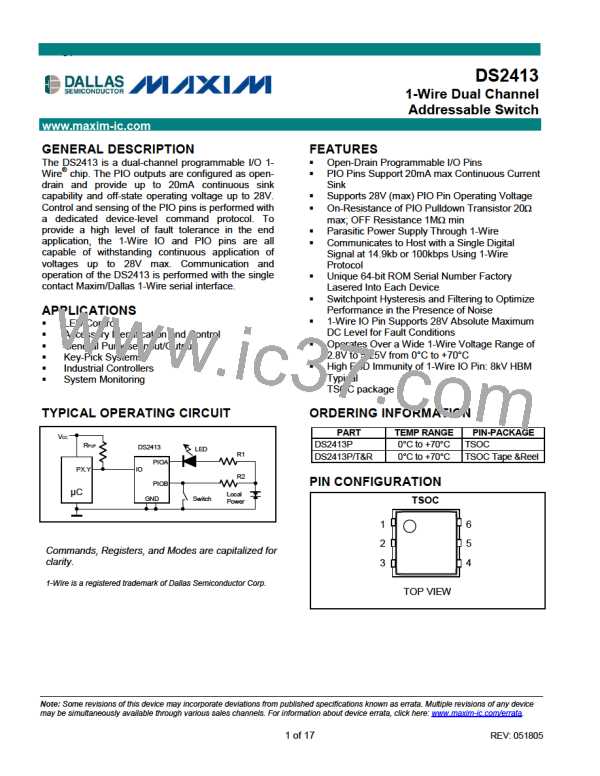DS2413: 1-Wire Dual Channel Addressable Switch
Master-to-Slave
For a write-one time slot, the voltage on the data line must have crossed the VTH threshold before the write-one
low time tW1LMAX is expired. For a write-zero time slot, the voltage on the data line must stay below the VTH
threshold until the write-zero low time tW0LMIN is expired. For the most reliable communication, the voltage on the
data line should not exceed VILMAX during the entire tW0L or tW1L window. After the VTH threshold has been crossed,
the DS2413 needs a recovery time tREC before it is ready for the next time slot.
Slave-to-Master
A read-data time slot begins like a write-one time slot. The voltage on the data line must remain below VTL until the
read low time tRL is expired. During the tRL window, when responding with a 0, the DS2413 starts pulling the data
line low; its internal timing generator determines when this pulldown ends and the voltage starts rising again. When
responding with a 1, the DS2413 does not hold the data line low at all, and the voltage starts rising as soon as tRL is
over.
The sum of tRL + ꢂ (rise time) on one side and the internal timing generator of the DS2413 on the other side define
the master sampling window (tMSRMIN to tMSRMAX) in which the master must perform a read from the data line. For the
most reliable communication, tRL should be as short as permissible, and the master should read close to but no
later than tMSRMAX. After reading from the data line, the master must wait until tSLOT is expired. This guarantees
sufficient recovery time tREC for the DS2413 to get ready for the next time slot. Note that tREC specified herein
applies only to a single DS2413 attached to a 1-Wire line. For multidevice configurations, tREC needs to be
extended to accommodate the additional 1-Wire device input capacitance. Alternatively, an interface that performs
active pullup during the 1-Wire recovery time such as the DS2482-x00 or DS2480B 1-Wire line drivers can be
used.
IMPROVED NETWORK BEHAVIOR (SWITCHPOINT HYSTERESIS)
In a 1-Wire environment, line termination is possible only during transients controlled by the bus master (1-Wire
driver). 1-Wire networks, therefore, are susceptible to noise of various origins. Depending on the physical size and
topology of the network, reflections from end points and branch points can add up, or cancel each other to some
extent. Such reflections are visible as glitches or ringing on the 1-Wire communication line. Noise coupled onto the
1-Wire line from external sources can also result in signal glitching. A glitch during the rising edge of a time slot can
cause a slave device to lose synchronization with the master and, consequently, result in a search ROM command
coming to a dead end or cause a device-specific function command to abort. For better performance in network
applications, the DS2413 uses a new 1-Wire front end, which makes it less sensitive to noise and also reduces the
magnitude of noise injected by the slave device itself.
The 1-Wire front end of the DS2413 differs from traditional slave devices in four characteristics.
1) The falling edge of the presence pulse has a controlled slew rate. This provides a better match to the line
impedance than a digitally switched transistor, converting the high-frequency ringing known from traditional
devices into a smoother low-bandwidth transition. The slew-rate control is specified by the parameter tFPD
,
which has different values for standard and Overdrive speed.
2) There is additional low-pass filtering in the circuit that detects the falling edge at the beginning of a time slot.
This reduces the sensitivity to high-frequency noise. This additional filtering does not apply at Overdrive speed.
3) There is a hysteresis at the low-to-high switching threshold VTH. If a negative glitch crosses VTH but does not go
below VTH - VHY, it will not be recognized (Figure 13, Case A). The hysteresis is effective at any 1-Wire speed.
4) There is a time window specified by the rising edge hold-off time tREH during which glitches are ignored, even if
they extend below VTH - VHY threshold (Figure 13, Case B, tGL < tREH). Deep voltage droops or glitches that
appear late after crossing the VTH threshold and extend beyond the tREH window cannot be filtered out and are
taken as the beginning of a new time slot (Figure 13, Case C, tGL O tREH).
Only devices that have the parameters tFPD, VHY, and tREH specified in their electrical characteristics use the
improved 1-Wire front end.
15 of 17

 MAXIM [ MAXIM INTEGRATED PRODUCTS ]
MAXIM [ MAXIM INTEGRATED PRODUCTS ]